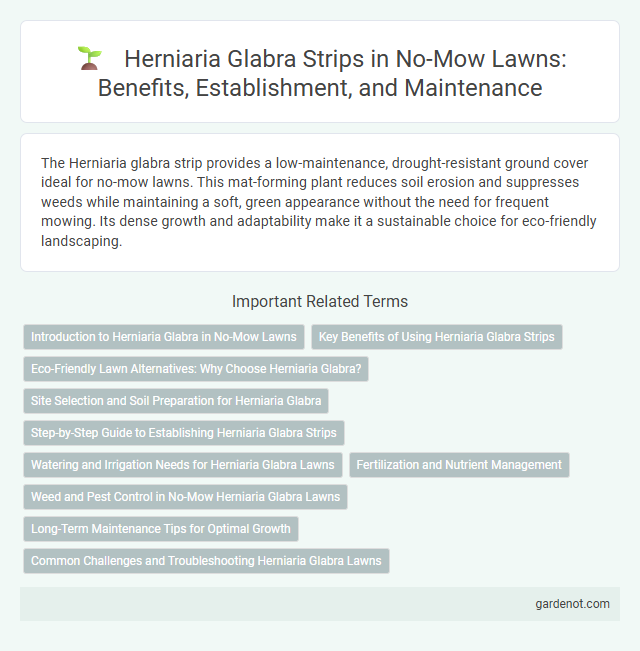The Herniaria glabra strip provides a low-maintenance, drought-resistant ground cover ideal for no-mow lawns. This mat-forming plant reduces soil erosion and suppresses weeds while maintaining a soft, green appearance without the need for frequent mowing. Its dense growth and adaptability make it a sustainable choice for eco-friendly landscaping.
Introduction to Herniaria Glabra in No-Mow Lawns
Herniaria glabra, commonly known as smooth rupturewort, is an ideal groundcover for no-mow lawns due to its low growth habit and minimal maintenance needs. This drought-tolerant perennial spreads quickly, forming a dense, green mat that suppresses weeds and reduces the need for frequent mowing. Its ability to thrive in poor soils and withstand foot traffic makes it a sustainable alternative to traditional grass lawns.
Key Benefits of Using Herniaria Glabra Strips
Herniaria glabra strips offer excellent soil stabilization and weed suppression due to their dense, mat-forming growth habit, reducing the need for frequent mowing. Their drought tolerance and low maintenance requirements make them ideal for sustainable, no-mow lawns in diverse climates. These strips enhance soil moisture retention and improve overall lawn resilience against erosion and pests.
Eco-Friendly Lawn Alternatives: Why Choose Herniaria Glabra?
Herniaria glabra, also known as smooth rupturewort, offers a sustainable, low-maintenance alternative to traditional grass lawns, reducing water consumption and eliminating the need for chemical fertilizers and pesticides. This resilient ground cover forms a dense, drought-tolerant mat that suppresses weeds naturally, promoting biodiversity and enhancing soil health. Choosing Herniaria glabra supports eco-conscious landscaping by preserving natural resources and lowering carbon footprints associated with lawn care.
Site Selection and Soil Preparation for Herniaria Glabra
Herniaria glabra thrives best in well-drained, sandy or loamy soils with a pH range of 6.0 to 7.5, making site selection critical for optimal growth. Preparing the soil involves thorough loosening and removal of weeds to reduce competition, along with incorporating organic matter to enhance soil fertility and moisture retention. Selecting a sunny location improves photosynthesis efficiency, promoting dense ground cover necessary for an effective no-mow lawn with Herniaria glabra.
Step-by-Step Guide to Establishing Herniaria Glabra Strips
Establishing Herniaria glabra strips begins with selecting a well-drained, sunny location to ensure optimal growth. Prepare the soil by removing weeds and loosening the top layer to a depth of 10-15 cm, then sow seeds evenly at a rate of 5-10 grams per square meter. Maintain consistent moisture levels through gentle watering until the plants are fully established, typically within 4-6 weeks, while avoiding mower use to allow dense mat formation.
Watering and Irrigation Needs for Herniaria Glabra Lawns
Herniaria glabra lawns require minimal watering due to their drought-tolerant nature, thriving best with infrequent irrigation that mimics natural rainfall patterns. Overwatering can lead to root rot and poor lawn health, so it's advisable to water only when the soil feels dry to the touch at a depth of about one inch. Drip irrigation or light, infrequent sprinkling ensures optimal moisture levels, promoting a dense, resilient no-mow lawn with low maintenance needs.
Fertilization and Nutrient Management
Herniaria glabra thrives with balanced fertilization, requiring moderate nitrogen levels to promote healthy, dense growth without excessive leafiness. Incorporating slow-release fertilizers rich in phosphorus and potassium enhances root development and stress tolerance, crucial for no-mow lawns. Regular soil testing ensures optimal nutrient availability, preventing nutrient deficiency or over-fertilization that can damage this resilient groundcover.
Weed and Pest Control in No-Mow Herniaria Glabra Lawns
Herniaria glabra effectively suppresses weed growth by forming a dense mat that blocks sunlight, reducing the opportunity for weed seeds to germinate and establish. Its low-growing, resilient nature minimizes pest habitats, decreasing the presence of common lawn pests such as grubs and aphids. This combination enhances weed and pest control, making no-mow Herniaria glabra lawns a sustainable alternative to traditional turfgrass management.
Long-Term Maintenance Tips for Optimal Growth
Herniaria glabra thrives in well-drained soil with moderate sunlight, requiring minimal watering once established, making it ideal for no-mow lawns. Regularly removing debris and occasional light trimming help maintain its dense, low-growing carpet-like appearance. Long-term maintenance involves monitoring soil pH between 6.0 and 7.5 and preventing invasive weed species to ensure optimal growth and sustainability.
Common Challenges and Troubleshooting Herniaria Glabra Lawns
Herniaria glabra lawns often face challenges such as drought sensitivity and patchy growth due to uneven soil moisture and poor nutrient availability. To troubleshoot these issues, ensure consistent irrigation during dry periods and conduct soil testing to optimize fertilization tailored to maintaining dense, low-maintenance coverage. Regular monitoring for pests like white grubs and applying organic treatments can further enhance the health and uniformity of a Herniaria glabra strip.
Herniaria glabra strip Infographic

 gardenot.com
gardenot.com